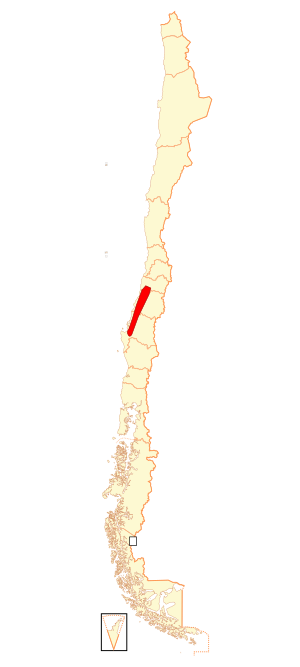Chile Darwin's frog facts for kids
Quick facts for kids Chile Darwin's frog |
|
|---|---|
| Conservation status | |
| Scientific classification | |
 |
|
| Range of Rhinoderma rufum (in red) | |
| Synonyms | |
|
Heminectes rufus Philippi, 1902 |
The Chile Darwin's frog (Rhinoderma rufum) is a very special frog. It is also known as the northern Darwin's frog. This frog is one of only two types in its family, called Rhinodermatidae. It lives only in central Chile, which means it is endemic there. Sadly, scientists think it might already be extinct.
Contents
What Does It Look Like?
The Chile Darwin's frog is quite small. It measures about 32 millimeters (1.3 inches) from its snout to its bottom. It has a unique fleshy nose, like a small trunk. Its legs are thin, and its feet have webs between some of its toes.
The color of these frogs can change a lot. They are usually brown or green, or a mix of both. Their bellies are often spotted with black and white patterns.
How It Lives
This frog is active during the day. It likes to eat small insects and other tiny creatures. When it's time to lay eggs, the female frog puts a small group of eggs on damp ground.
About a week later, the baby frogs start to move inside the eggs. This is when the male frog steps in! He picks up the eggs and keeps them safe in his vocal sac. This is a special pouch in his throat. He holds them there until they have grown enough to digest food. Then, he takes them to a good water spot and lets them go. The tadpoles finish growing in the water. They then change into frogs through a process called metamorphosis. This is different from its cousin, the Darwin's frog. Those tadpoles stay in the parent's vocal sac until they are fully grown.
Where Does It Live?
The Chile Darwin's frog lives in a very small area in central Chile. It has been found in Talca Province and south towards Bío Bío Province. Not much is known about where these frogs live. But they probably prefer temperate forests, rivers, and swamps. They have been seen in wet beech forests. These forests are usually between 50 and 500 meters (164 to 1,640 feet) above sea level. The Chile Darwin's frog used to live in the same areas as the Darwin's frog near Concepcion.
Why Is It Endangered?
The IUCN (International Union for Conservation of Nature) says the Chile Darwin's frog is "Critically Endangered." This means it is at very high risk of disappearing forever. The last time anyone saw one for sure was around 1981. So, it might already be extinct.
The biggest dangers to these frogs are the destruction of their forest homes. Building new things also harms their habitat. However, scientists are not sure why their numbers dropped so quickly. It might be because of a disease called chytridiomycosis. This disease affects amphibians. But it was not reported in Chile when the frogs started to disappear. If any of these frogs are still alive, they are likely threatened by habitat loss, pollution, and this disease.
In 2008, a group called EDGE (Evolutionarily Distinct and Globally Endangered) listed the Chile Darwin's frog as one of the most unique and endangered species. They said that many amazing amphibians are not getting enough help.
Want to Learn More?

- In Spanish: Ranita Chilena de Darwin para niños
- Gastric-brooding frog
- Mouthbrooder


